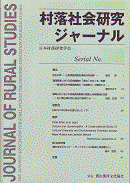Volume 27, Issue 1
Displaying 1-8 of 8 articles from this issue
- |<
- <
- 1
- >
- >|
ARTICLE
-
Article type: research-article
2020 Volume 27 Issue 1 Pages 1-12
Published: October 25, 2020
Released on J-STAGE: September 09, 2021
Download PDF (1070K) -
Article type: research-article
2020 Volume 27 Issue 1 Pages 13-24
Published: October 25, 2020
Released on J-STAGE: September 09, 2021
Download PDF (1122K)
ARCHIVES
-
Article type: oration
2020 Volume 27 Issue 1 Pages 25-33
Published: October 25, 2020
Released on J-STAGE: September 09, 2021
Download PDF (1091K)
BOOK REVIEWS
-
2020 Volume 27 Issue 1 Pages 34-35
Published: October 25, 2020
Released on J-STAGE: September 09, 2021
Download PDF (627K) -
Article type: book-review
2020 Volume 27 Issue 1 Pages 36-37
Published: October 25, 2020
Released on J-STAGE: September 09, 2021
Download PDF (662K) -
Article type: book-review
2020 Volume 27 Issue 1 Pages 38-39
Published: October 25, 2020
Released on J-STAGE: September 09, 2021
Download PDF (660K) -
2020 Volume 27 Issue 1 Pages 40-41
Published: October 25, 2020
Released on J-STAGE: September 09, 2021
Download PDF (625K) -
Article type: book-review
2020 Volume 27 Issue 1 Pages 42-43
Published: October 25, 2020
Released on J-STAGE: September 09, 2021
Download PDF (627K)
- |<
- <
- 1
- >
- >|
